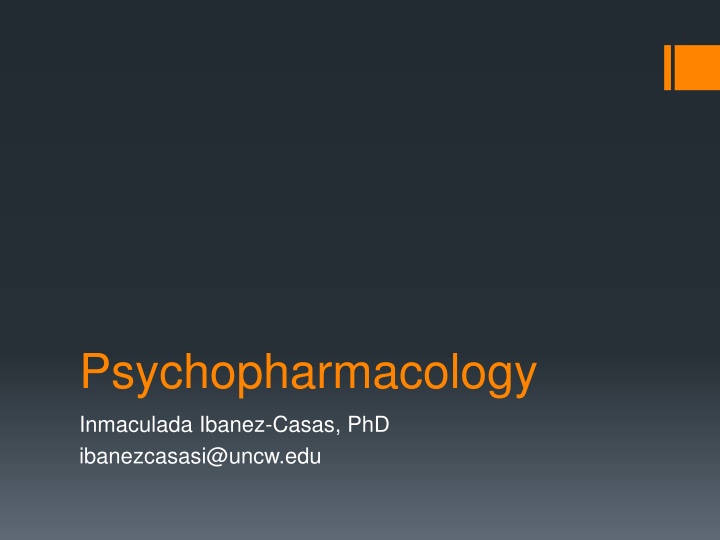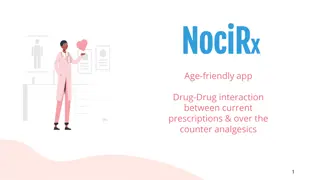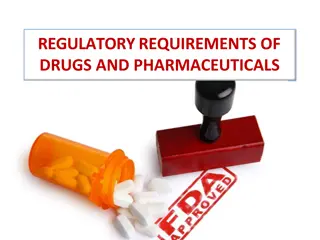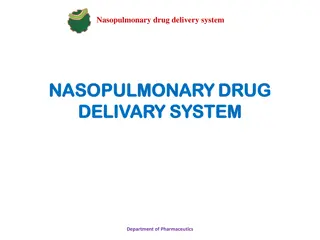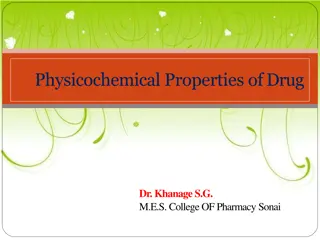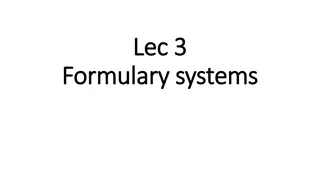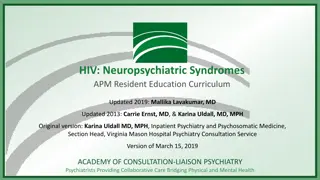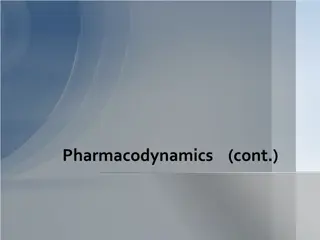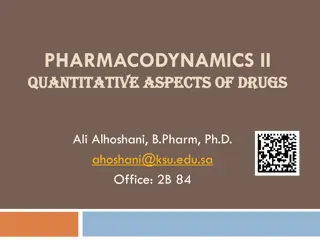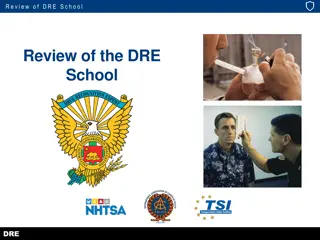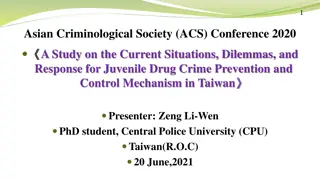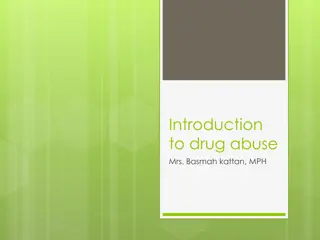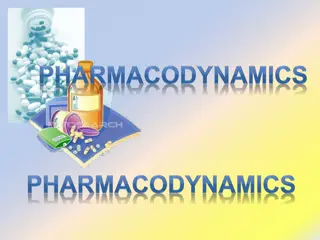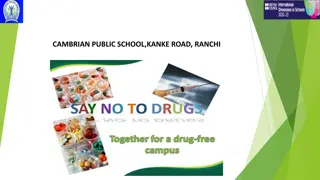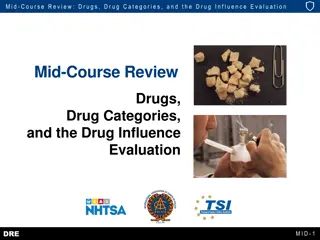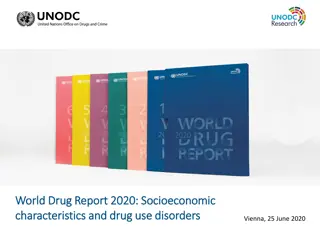Basic Principles of Psychopharmacology and Drug Effects
Psychopharmacology is the study of drugs' effects on the nervous system and behavior, encompassing routes of administration, drug actions, neurotransmitters, and more. Understanding drug absorption, distribution, metabolism, and excretion is crucial in determining their impact. Factors like tolerance, sensitization, and withdrawal symptoms also play a role in drug effectiveness. Explore the diverse aspects of psychopharmacology to grasp the intricate interplay between drugs and the body.
Download Presentation

Please find below an Image/Link to download the presentation.
The content on the website is provided AS IS for your information and personal use only. It may not be sold, licensed, or shared on other websites without obtaining consent from the author.If you encounter any issues during the download, it is possible that the publisher has removed the file from their server.
You are allowed to download the files provided on this website for personal or commercial use, subject to the condition that they are used lawfully. All files are the property of their respective owners.
The content on the website is provided AS IS for your information and personal use only. It may not be sold, licensed, or shared on other websites without obtaining consent from the author.
E N D
Presentation Transcript
Psychopharmacology Inmaculada Ibanez-Casas, PhD ibanezcasasi@uncw.edu
Psychopharmacology SUMMARY Basic principles of psychopharmacology: routes of administration and their fate in the body. Sites of drug actions. Specific neurotransmitters: physiological and behavioral effects of specific drugs
Psychopharmacology SUMMARY Basic principles of psychopharmacology: routes of administration and their fate in the body. Sites of drug actions. Specific neurotransmitters: physiological and behavioral effects of specific drugs
Principles of Psychopharmacology Psychopharmacology the study of the effects of drugs on the nervous system and on behavior Routes of administration the path by which a drug or other substance is taken into the body Drug Effect the changes a drug produces in an animal s physiological processes and behavior Sites of Action the locations at which molecules of drugs interact with molecules located on or in cells of the body, thus affecting some biochemical processes of these cells
Principles of Psychopharmacology Pharmacokinetics movements of drugs, including the process by which drugs are absorbed, distributed within the body, metabolized, and excreted. Body Drug Bloodstream Organ/Tissue Molecule
Principles of Psychopharmacology Effects of Repeated Administration Tolerance a decrease in the effectiveness of a drug that is administered repeatedly Sensitization an increase in the effectiveness of a drug that is administered repeatedly Withdrawal Symptom the appearance of symptoms opposite to those produced by a drug when the drug is administered repeatedly and then suddenly no longer taken Placebo an inert substance that is given to an organism in lieu of a physiologically active drug
Routes of Administration Intravenous (IV) Injection Intraperitoneal (IP) Injection Intramuscular (IM) Injection Subcutaneous (SC) Oral Administration Sublingual Administration Intrarectal Administration Inhalation Topical Administration Intracerebral Administration Intracerebroventricular (ICV) Administration
Psychopharmacology SUMMARY Basic principles of psychopharmacology: routes of administration and their fate in the body. Sites of drug actions. Specific neurotransmitters: physiological and behavioral effects of specific drugs
Entry of Drugs into the Brain Blood-brain barrier
Sites of Drug Action Figure 6.6. The synthesis, packaging, secretion, and removal of neurotransmitters.
Sites of Drug Action Effects of Drugs Antagonist a drug that opposes or inhibits the effects of a particular neurotransmitter Agonist a drug that facilitates the effects of a particular neurotransmitter
Sites of Drug Action Effects on Production of Neurotransmitters Effects on Storage and Release of Neurotransmitters Effects on Receptors Effects on Reuptake or Destruction of Neurotransmitters
Sites of Drug Action Level AGONIST ANTAGONIST Increasing precursor (e.g. L-Dopa) Stimulating NT release (vesicles) (e.g. Black widow venom) Deactivating synthetic enzymes (e.g. PCPA) Inhibiting filling of vesicles (e.g. Reserpine) Inhibiting the release of NT (e.g. Botulinum toxin) Inhibiting postsynaptic receptors (e.g. Atropine) Synthesis Release Stimulating postsynaptic receptors (e.g. Nicotine) Postsynaptic receptors Autoreceptors Blocking autoreceptors Stimulating autoreceptors (e.g. Apomorphine) Blocking reuptake (e.g. Cocaine, SSRI s) Reuptake Preventing enzymatic deactivation (e.g. Physostigmine) Deactivation
Psychopharmacology SUMMARY Basic principles of psychopharmacology: routes of administration and their fate in the body. Sites of drug actions. Specific neurotransmitters: physiological and behavioral effects of specific drugs
Types of Neurotransmitters Glutamate GABA Glicine Aminoacids Opioids Substance P Peptides Vasopressin Dopamine Epinephrine Norepinephrine Catecholamines Monoamines Serotonin Histamine Other Acetylcholine
Peptides Peptide Vasopressin Function Stress response Oxytocin Uterine contractions Milk reflex Movement disorders Pain perception Pain relief Substance P Opioid
Dopamine 20 Pathways include: Projections from Substantia Nigra (basal ganglia) Parkinson s disease Projections to the nucleus accumbens Pleasure center of brain Substance use disorders Schizophrenia: mesolimbic pathway Regulation of emotional responses Substances: Cocaine, Amphetamine
Epinephrine Energy and Emergency systems: Fight or Flight responses ANS (Sympathetic): regulating blood pressure CNS: forming of new memories
Norepinephrine Involved in: Sympathetic NS: Fight or Flight Increases blood pressure and heart rate Releases glucose stores Emotional arousal: connected to amygdala Reward / Reinforcement Regulation of sleep and mood Substances: Cocaine, Amphetamine
Serotonin Functions Inhibitory NT Mood, emotion, appetite and sleep (Hippothalamus) Low levels = depression, anger, OCD SSRI Temperature regulation Sensory perception Substances: LSD, SSRI
Acetylcholine Involved in Somatic NS: Muscle contraction Central NS: Learning and memory Alzheimer s disease
Psychopharmacology Inmaculada Ibanez-Casas, PhD ibanezcasasi@uncw.edu
